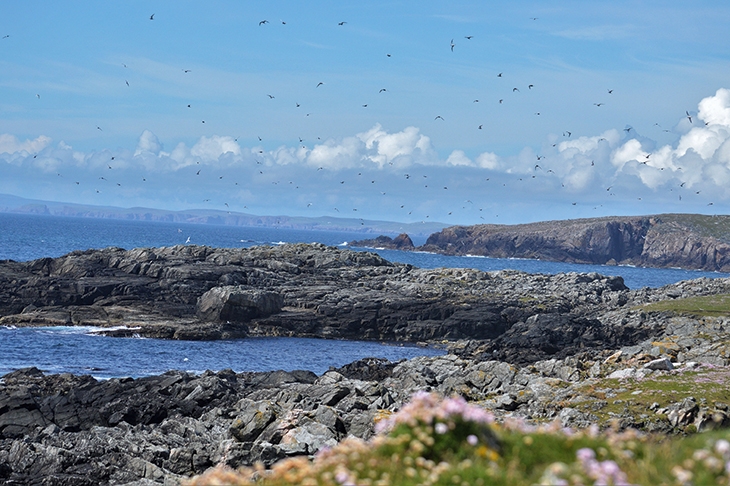After kayaking solo in a November storm to a square mile of rock called Eilean a’Chleirich in the Summer Isles off the north-west coast of Scotland, and camping overnight on top of its cliffs, David Gange awoke to revelation. To the west he could see almost the entire length of the Outer Hebrides. To the north-east the mainland, with its distinctive peaks, stretched towards Cape Wrath. The British Isles may be diminutive on a global scale but, Gange realised, ‘just how small they really are depends on how you measure them’. Merely the first hundred miles of longitude on the mainland’s north-west coast hold thousands of miles of coastline, with mountains, bays, estuaries, cliffs and islets — ‘enough to repay a lifetime’s exploration’. At that moment, he writes, the ‘need’ to undertake the journey described in The Frayed Atlantic Edge was born.
And so begins a journey by kayak down the western littoral of the British Isles. Paddling from Shetland to Cornwall over the course of the seasons, and taking in Orkney, the Western Isles, Sutherland, Skye, Argyll, Ulster, Connacht, Munster, and Bardsey Island in North Wales, Gange is both extraordinarily intrepid and deeply attentive to all he encounters, and his prose runs, breaks and shifts with the force and beauty of the seas that bear him. Near the great cliffs at Eshaness in Shetland, he describes how the swell of the water
was immensely peaceful, its phases gentle and unthreatening as I moved through four dimensions with every stroke. But at the bottom of the cliffs, the swell seemed to come from all directions at once: unpredictable and disorienting.
Paddling into what had once been a volcano
it felt strangely appropriate that in a spot where I was separated from writhing magma only by time, I should be plunging and leaping with violent swell, head rhythmically falling beneath where my feet had been.
By contrast, on the west coast of the Outer Hebrides, his gaze, and the reader’s, is captivated by the colours and shapes of the land:
A few feet of marram [grass] can fix loose sand in place, and in its shelter the carnival begins: red fescue, sand sedge, buttercup and primrose… Cloud clings to the high peat ground inland, while the sun shines more often on these low, flower-clad expanses. Looking up from the kayak even at the end of summer, it’s as if the foreground were painted in children’s colours: a shock of vivid greens, yellows, pinks and oranges. Behind is the sombre painting in night-time hues of brown, blue-grey and black.
If this were just another book by what the Scottish poet Kathleen Jamie once described, perhaps a little too unkindly, as a ‘lone enraptured male’, it would still be pretty good. But The Frayed Atlantic Edge is much more than that. Gange teaches modern history at the University of Birmingham, and his interest in the people and communities who once lived, and live, along these coasts is as great as his passion for the physical environment and non-human life.
During his journey, and in this account of it, he spends a lot of time — much of it during rest stops while on the water — reading up on the human past. He also talks to archaeologists, ecologists, naturalists, geographers, anthropologists, artists, poets, novelists and musicians, bringing their voices to the page. The book is illustrated with arresting and beautiful photographs by the author and fine maps.
Gange argues that the significance of the western edge of the archipelago has been consistently underestimated in the stories we tell ourselves about life in these islands. ‘The whole shape of British history is transformed by granting the Atlantic coasts a central rather than a marginal role.’ These places thrived during the Dark Ages, he writes, and are enjoying a cultural and linguistic renaissance today. ‘Recovering the voices of the small-scale fisherman, the coastal crofter and the leaders of threatened communities is among the best methods we have of building histories that aren’t triumphalist propaganda…’
We live in fluid, fissiparous times. Two thirds of the members of the political party that chose Boris Johnson to be prime minister told pollsters that they would accept Scottish independence as a price of Britain leaving the European Union. The future in these islands looks likely to be ruptured and rearranged by powerful forces surfacing from both within and without. If, as the philosopher Bruno Latour argues, we need a new politics of ‘the terrestrial’ to confront a climate crisis that will not stop at any wall or customs declaration counter, then work such as Gange’s, which brings the reader closer to some realities of land and sea, and to the past and present lives intertwined with those realities, is worth attention for its deeper argument as well as its thrilling surface.






Comments